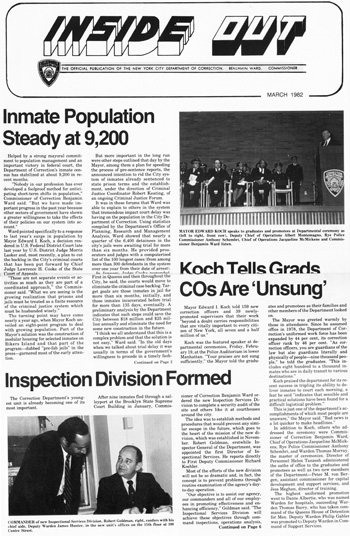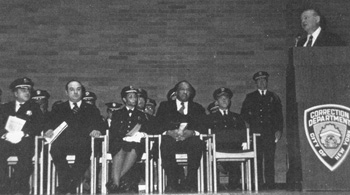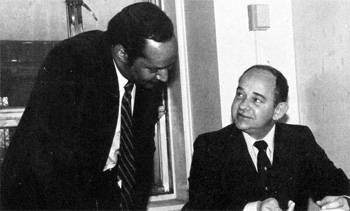DOC's previous newsletters had been named Sidelights and The Pen. The staff of Inside Out included Errol D. Toulon, then a C.O. who served as its photographer. In due course, he would rise through the ranks to become Correction Academy Deputy Warden during the 1990s. In the summer of 2010, Toulon, a Monroe College professor, made available to this website a copy of the March 1982 issue of Inside Out. [See image of Page 1 at right.] From that issue copy, the New York Correction History Society webmaster has created this eight-page web presentation of extracted images and texts, one web page for each of the issue's eight printed pages. Near the bottom of each of the presentation's eight web pages is a descriptive list of links to all its pages. The images and texts on this web page were extracted from that newsletter's Page 1 .  Helped by a strong mayoral commitment to population management and an important victory in federal court, the Department of Correction’s inmate census has stabilized at about 9,200 in recent months. “Nobody in our profession has ever developed a foolproof method for anticipating short-term shifts in population,” Commissioner of Correction Benjamin Ward said. Ward pointed specifically to a response to last year’s surge in population by Mayor Edward I. Koch, a decision rendered in U.S. Federal District Court late last year by U.S. District Judge Morris Lasker and, most recently, a plan to cut the backlog in the City’s criminal courts that has been put forward by Chief Judge Lawrence H. Cooke of the State Court of Appeals. “These are not separate events or activities so much as they are part of a coordinated approach,” the Commissioner said. “What we are seeing is the growing realization that prisons and jails must be treated as a finite resource of the criminal justice system which must be husbanded wisely.” The turning point may have come nearly a year ago, when Mayor Koch unveiled an eight-point program to deal with growing population. Part of the Mayor’s solution was the construction of modular housing for selected inmates on Rikers Island and that part of the program—dubbed “pre-fab jails” in the press—garnered most of the early attention. But more important in the long run were other steps outlined that day by the Mayor, among them a plan for speeding the process of pre-sentence reports, the announced intention to rid the City system of inmates already sentenced to state prison terms and the establishment, under the direction of Criminal Justice Coordinator Robert Keating, of an ongoing Criminal Justice Forum. It was in these forums that Ward was able to explain to others in the system that tremendous impact court delay was having on the population in the City Department of Correction. Using statistics compiled by the Department’s Office of Planning, Research and Management Analysis, Ward showed that nearly a quarter of the 6,400 detainees in the city’s jails were awaiting trial for more than six months. He provided prosecutors and judges with a computerized list of the 100 longest cases (from among more than 300 defendants in the system over one year from their date of arrest). In January, Judge Cooke responded. First in Queens and then throughout the City, he said, the courts would move to eliminate the criminal case backlog. Target goals are those inmates in jail for more than six months, initially, and those inmates incarcerated before trial for more than 135 days, eventually. A preliminary analysis by the Department indicates that such steps could save the City between $18 million and $25 million annually and eliminate the need for some new construction in the future. “I think we all understand that this is a complex problem and that the solution is not easy,” Ward said. “In the old days when we talked about trial delay it was usually in terms of the government’s willingness to procede in a timely fash-  The Correction Department’s youngest unit is already becoming one of its most important. After nine inmates fled through a salleyport at the Brooklyn State Supreme Court Building in January,
The idea was to establish methods and procedures that would prevent any similar escape in the future, which goes to the heart of the mission of the new division, which was established in November. Robert Goldman, erstwhile Inspector General of the Department, was appointed the first Director of Inspectional Services. He reports directly to First Deputy Commissioner Richard Koehler. Most of the efforts of the new division will not be so dramatic and, in fact, the concept is to prevent problems through routine examination of the agency’s day-to-day operation. “Our objective is to assist our agency, our commanders and all of our employees in promoting effectiveness and enhancing efficiency,” Goldman said. “The Inspectional Services Division will achieve these objectives through command inspections, operations analysis,
Also visit on this site:
|


